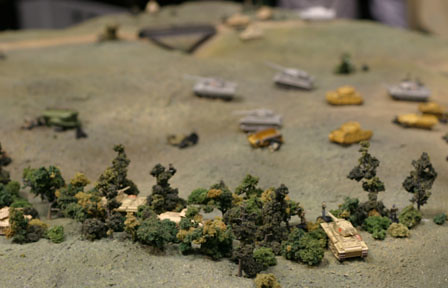I had high hopes for Blitzkrieg Commander, and it didn't disappoint. The rules are quick and intuitive--just tell the players how to issue orders, explain the few modifiers that the game uses, and you're off and running!
We played an "Exploitation" scenario taken from the main rulebook. I set the game in October 1943 as part of the Red Army's crossing of the Dnieper River. For our game, the Russians had already penetrated the main German line, so the German players would be commanding reserve units that weren't properly deployed for the coming assault.
Here's a look at my kitchen table just before the game started. We were playing "deep," so the Soviets entered on the closest short table edge and had to push through several layers of German defenses.

Here's the Soviet assault force: 6 T-34/76s (each with 1 infantry squad riding) plus an SU-122 with a few more infantry squads on the other flank. The BA-10 armored car is one of the two command units.

The Germans were deployed in several different areas of the board, which prevented them from mustering a solid counterattack initially.

In addition to scattered infantry and MG squads, the Germans had 2 Tiger I tanks, 1 Panzer IV tank and 1 Sturmpanzer Brummbar.

Plus a PaK-4o anti-tank gun! It was dug-in behind some hedges and drew first blood once the game got underway.
'

And thus the game began! The Russians had to capture as much territory as possible, and they started off by moving forward toward the small village in this photo. Both Red Army command units gave lackluster performances in these opening turns, giving the Germans time to pull back some troops and open fire with their PaK-40. The first kill was a T-34.
 The Soviets dumped their tank riders in this small village and attempted to drive straight through to continue the assault. Unfortunately the Brummbar was close enough to provide a serious roadblock to this plan.
The Soviets dumped their tank riders in this small village and attempted to drive straight through to continue the assault. Unfortunately the Brummbar was close enough to provide a serious roadblock to this plan.
On the other flank, the infantry pushed through another small village but spent waaay too much time attacking a dug-in MG unit. Because of this, they weren't able to keep up with the rest of the assault, and they didn't do too much damage. Note the smoking T-34 and SU-122 in the background.
 After several turns, the German players had the bright idea to move their Tigers up into the fray. They actually drove right up and parked atop the central hill, thus threatening a huge area with their guns. This maneuver proved to be the deathblow for the Soviets, as their 4 remaining T-34s spent the rest of the game trying desperately to stay away from the Tigers.
After several turns, the German players had the bright idea to move their Tigers up into the fray. They actually drove right up and parked atop the central hill, thus threatening a huge area with their guns. This maneuver proved to be the deathblow for the Soviets, as their 4 remaining T-34s spent the rest of the game trying desperately to stay away from the Tigers. Both the German and Soviet infantry units chewed each other to pieces in the urban areas, but not before the German infantry, armed with panzerfausts, drove several T-34s back into range of the Tigers. The final play came as the Tigers plunged into the woods in pursuit of the two remaining T-34s. The Soviet player (me) conceded the game after this photo.
Both the German and Soviet infantry units chewed each other to pieces in the urban areas, but not before the German infantry, armed with panzerfausts, drove several T-34s back into range of the Tigers. The final play came as the Tigers plunged into the woods in pursuit of the two remaining T-34s. The Soviet player (me) conceded the game after this photo. All in all, we found Blitzkrieg Commander to be a very satisfying game. In retrospect, I should have given the Soviet side a lot more points; the rulebook suggested that the attacker have double the points as the defender. The scenario as I set it up didn't have quite that disparity.
All in all, we found Blitzkrieg Commander to be a very satisfying game. In retrospect, I should have given the Soviet side a lot more points; the rulebook suggested that the attacker have double the points as the defender. The scenario as I set it up didn't have quite that disparity.The possibility of failing a command role at a critical time made for some very exciting play. We also liked that the turns weren't fixed; players could issue a bunch of orders, or fail after just one or two, thereby ending their turn.
We didn't include artillery or air support in our game, as we were just trying out the rules and didn't want to further complicate our learning session. But for our next game, I think we'll do a straight point build and see how the game plays that way.











